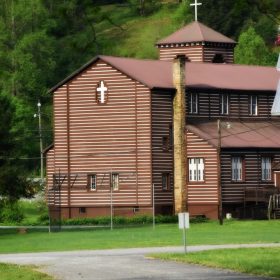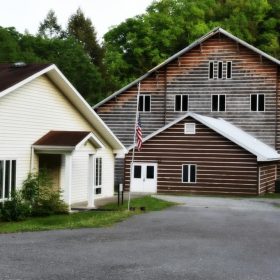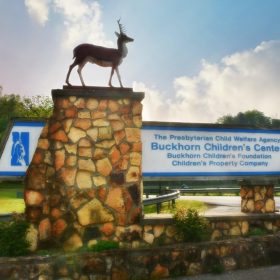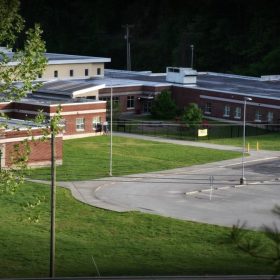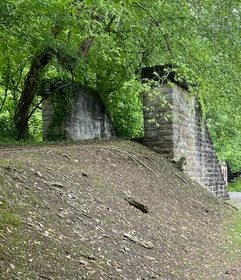A biography, Murdoch of Buckhorn (Nashville: Parthenon Press, 1946) by Gordon Mahy, Jr., describes the founding of Buckhorn as a community. Mahy’s book was the source for much of the information that follows.
The hills and hollers of Kentucky have always had itinerant preachers and part time pastors ordained by their congregations, but church buildings and seminary trained pastors were rare even at the end of the nineteenth century. The Rev. E(dward) O. Guerrant. a former Confederate officer and physician, identified eastern Kentucky as a region “practically without churches, Sabbath schools, or qualified teachers; whole counties with tens of thousands of people who had never seen a church, or heard a gospel sermon they could understand.”
Guerrant created a “Society of Soul Winners” that recruited missionaries and encouraged the building of small churches in rural Kentucky, Tennessee, and North Carolina. Rev. Harvey Murdoch, a Princeton graduate and pastor of the Cumberland Street Branch of the Lafayette Avenue Church in Brooklyn, after hearing the plight of the mountain folks, accepted an offer from Guerrant to become field secretary of the Society.
As field secretary, Murdoch was required to visit and encourage society workers throughout the region, and this brought him, after a long ride on horseback, to a church revival on Laurel Point overlooking Buckhorn at the junction of Squabble Creek with the Middle Fork of the Kentucky River. An elderly minister named Miles Saunders was leading the congregation in “Just as I Am,” and his daughter, Louise, was providing the accompaniment on a hand organ. Murdoch was invited inside and preached a spontaneous sermon that was well-received. Louise and Murdoch were attracted to each other, and within weeks, they were engaged, so in 1902 Murdoch wrote to Guerrant asking to be relieved of his duties as field secretary so that he could found a church and school in Buckhorn. The school was to be named Witherspoon College, after the founder of Princeton. Witherspoon was called a college, rather than a school, to encourage adults to enroll in classes.
The school blossomed. Louise and her father had been staying as guests of John Gross, who enthusiastically endorsed Murdoch’s vision. Leaders of the community gathered to discuss plans for the college and to donate building materials and some cash. John’s brother, Jack, provided the necessary land, and the Society of Soul Winners added two hundred dollars. The Lafayette Church in Brooklyn had been supporting Murdoch as field secretary with fifty dollars a month, so Murdoch decided to travel to Brooklyn and plead for his new school. He was received with enthusiasm and came back to Kentucky with one thousand dollars. Throughout the years that followed, Murdoch returned to Brooklyn every November, and Mahy reports that the Lafayette church underwrote almost the entire cost of the expanding program in Buckhorn.
The engaged couple were married in April of 1903, by which time they had their own log house, and four log windowless classrooms had been constructed. It was suggested to Murdoch that better buildings might be built, but he insisted upon logs, so that students would not feel that their own homes were inferior to their schoolrooms. Recruiting qualified teachers was difficult. There were too few volunteers, and those who were paid received a pittance, but there was a demand for education and the initial enrollment for 1903 rose from forty to eighty students.
Witherspoon College was a success. Year by year enrollment increased, and soon there was a circle of log buildings surrounding the baseball field at the center of the campus. Two buildings remain from Murdoch’s time, the “Log Cathedral,” home to the Buckhorn Lake Area Presbyterian Church and the Geer Gymnasium. The church was completed in 1928 and is on the National Registry of Historic Places. Edward Geer, a member of the Underwood family, makers of the typewriter of that name, provided the architect, but the building was built with local labor using local lumber hewn at the college’s saw mill. The gymnasium was finished a year earlier than the church and remained in use for over seventy years, after which the walls, roof, and floor were all replaced, leaving only the beams from the original building. Other original buildings were lost to fires between 1946 and 1954, and the log structures were replaced by the stone, cinder-block, and frame houses seen there today.
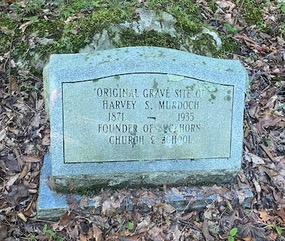 Often unwell, Louise Murdoch died during the 1918 influenza epidemic, and the college grieved. But life went on, an enthusiastic teacher, Mary Coke, came to teach the kindergartners, and she and Murdoch were married on October 13, 1921. There were no children from either marriage. When Murdoch died in 1935, he was buried on Laurel Point near where he first met Louise, but after Mary moved from Buckhorn back to her family in central Kentucky and remarried, she arranged for Murdoch’s body to be moved next to Louise’s gravesite in the Bellevue Cemetery, Danville. A stone marker stands on Laurel Point to mark Murdoch’s original burial site.
Often unwell, Louise Murdoch died during the 1918 influenza epidemic, and the college grieved. But life went on, an enthusiastic teacher, Mary Coke, came to teach the kindergartners, and she and Murdoch were married on October 13, 1921. There were no children from either marriage. When Murdoch died in 1935, he was buried on Laurel Point near where he first met Louise, but after Mary moved from Buckhorn back to her family in central Kentucky and remarried, she arranged for Murdoch’s body to be moved next to Louise’s gravesite in the Bellevue Cemetery, Danville. A stone marker stands on Laurel Point to mark Murdoch’s original burial site.
Following Murdoch’s death, leadership of the college and church passed on to a Witherspoon graduate, Elmer Gabbard, who, like Murdoch, attended Princeton Theological Seminary. Gabbard steered the college through the Depression, when many parents, unable to support their children, sent them as boarders to Buckhorn. At this time there were over four hundred children enrolled, attending classes, but also working. The older boys tended the farm and its animals, while the girls cooked, sewed, and did other domestic chores.
Dr. Gabbard stepped down in 1957 and a K-12 public school was established adjacent to Squabble Creek on land previously owned by the college. At that time, Witherspoon College ceased to exist, its place being taken by the new Buckhorn School, the Buckhorn Presbyterian Church (later the Buckhorn Lake Area Church), and the Buckhorn Children’s Center, formally the Presbyterian Child Welfare Agency (PCWA) or, an orphanage housing sixty-six children. By the 1970s, the PCWA had made the transition from orphanage to cottages for normal children from difficult families. Subsequently, they became a treatment facility for children with social or emotional problems, and more recently they offer a recovery center for adults who have suffered from addiction.
In the early years, the best way to get to Buckhorn was to ride the train to Elketawa, four miles west of the train’s last stop in Jackson, and then ride a horse or mule for six hours south to Buckhorn on a trail of which a visitor commented, “I couldn’t tell if the creek was in the road or the road was in the creek.” In 1924, motivated by the growing fame of Witherspoon College, the Kentucky legislature passed a bill authorizing a state highway from Buckhorn to Booneville, and the road was completed five years later. By 1936 the road connecting Buckhorn to Route 15 west of Hazard was also under construction.
For many years residents of Buckhorn became inured to flooding of the Kentucky River every spring. In 1957 the river rose so high that flood water in the Log Cathedral was over three feet deep in the balconies! Although its records were destroyed, the building survived. Other homes in the area were not so fortunate. A local resident recalls being evacuated to a hillside and watching the muddy water surge around his home, which was held in place only by electric power lines. Alas, the power lines snapped, and the doomed house floated downstream.
To mitigate future flooding, a ten-million-dollar “flood control and water storage” ichwas already under construction on the river immediately adjacent to the former Witherspoon campus. Buckhorn Lake, which was created by this dam, covered Route 28 leading from Buckhorn east toward Chavies, and the highway was rerouted along adjacent ridges, as were homes in the affected area. As a result, unless one takes a boat, it is impossible today to get from Buckhorn to Hazard, its county seat, without passing through another county. The dam was dedicated on September 10, 1960, and filling began immediately. The dam is maintained by the U.S. Army Corps of Engineers, who maintains an office on top of the dam and supervises a playground and campground below it. Both the lake and river below the the spillway are popular spots for fishermen seeking blue gills, bass, catfish, trout, and muskellunge, among other species.
During construction of the dam, many of the workers slept in a dormitory under the Sparks Trading Post and ate their meals there. The trading post was the rural equivalent of a department store, and the north end of the building houses the Buckhorn Post Office. For years afterwards shoppers could buy anything from furniture, clothing, and tombstones to hardware, bologna sandwiches, and fishing gear. The store closed on December 31, 2023, but a sign painted on its side wall still reads “SPARKS HAS IT.”
With as many as 500 children in residence, Witherspoon College needed a “hospital.” It was located on the hill above the campus and was served by a nurse who lived there and a full-time doctor, who lived in Buckhorn. A local clinic with nurses and nurse practitioners served the community after Witherspoon College closed. Since 1985, there has been a full-time physician at the Buckhorn Medical Clinic, which is affiliated with the Mountain Comprehensive Health Corporation (MCHC) and is open weekdays from 8:30 AM to 5:00 PM.
